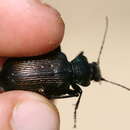Comprehensive Description
(
Inglês
)
fornecido por Smithsonian Contributions to Zoology
Calosoma abbreviatum Chaudoir
Calosoma abbreviatum Chaudoir, 1869:371. [Holotype male, PERU or BOLIVIA (LaFerté-Sénectèrt) (MNHP).]
DIAGNOSTIC COMBINATION.—Among our species with foveate elytral intervals 3, 7, and 11, this species is easily recognized by its metallic green color, non-contrasting elytral foveae, and blunt metatrochanters. Color and luster: brassy green, forebody more green; mouthparts, appendages, and venter dark piceous. Form: size small to medium, relatively broad; female elytra expanded; eyes large and prominent Structure: elytral intervals shallowly convex, 3, 7, and 11 catenate with large foveae, all transversely scaly; head finely rugosely punctate. Microsculpture finely isodiametric, effaced from pronotum, pronotum with finely and coarsely punctate surface. Male with 3 dilated basal tarsal articles on foreleg, each with setiferous pad beneath; middle tibia with large brush of setae apicomedially; metatrochanter apically truncate; and male median lobe apex straight and broadly rounded. Female without tarsal pads; with blunt metatrochanter; and with multiple setae on sternum VI. ABL = 22.0 to 25.0 mm; TW = 8.5 to 10.0 mm (from Gidaspow 1963).
GEOGRAPHICAL DISTRIBUTION.—The range of this species extends from about 15°S to 3°N latitude along the west coast of South America. It can be expected to occur on the Azuero Peninsula or in the Darièn (when the latter is cut over for agriculture.)
NATURAL HISTORY.—According to Gidaspow (1963), these beetles live in cotton-growing regions of Peru, on the brush-covered plains of Colombia, and in sandy areas between the coast and oak covered foothills of Ecuador and Peru. Should the west coast of Panama (Darien) be opened to agriculture, it is possible these beetles could expand their range northward. These beetles are fully winged and no doubt fly quite well.
MATERIAL EXAMINED.—Type (see above) and 4 specimens from Peru.
- citação bibliográfica
- Erwin, Terry L. 1991. "The ground beetles of Central America (Carabidae) I: Carabinae (in part): Notiophilini, Loricerini, Carabini." Smithsonian Contributions to Zoology. 1-30. https://doi.org/10.5479/si.00810282.501

